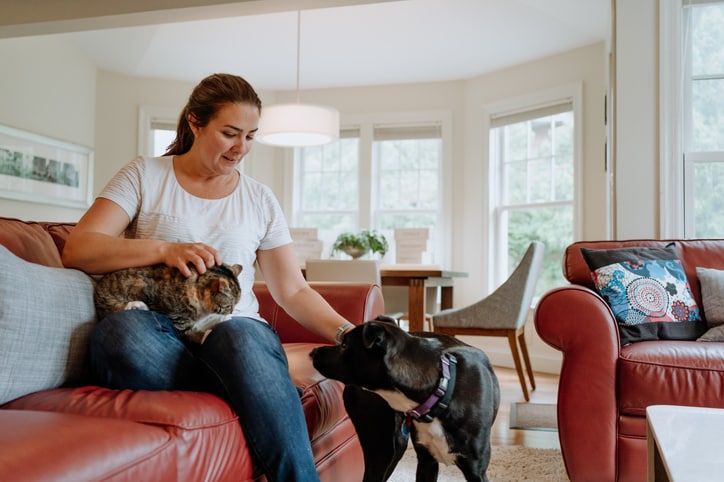You know your dog looks at you with eyes of love, but what is dog vision really like? Is doggy eyesight better than ours? What are the myths, and what is the sharp-eyed lowdown?
Are Dogs Color Blind?
Your Irish setter may not fully appreciate his gorgeous hue, but dogs can see some color. “There are two types of photoreceptors in the eye, tasked with perceiving sharpness and color, called rods and cones,” explains Dr. Michael H. Brown, a veterinary ophthalmologist with Animal Eyes of New Jersey. “Like people, dogs have these photoreceptors in their retinas, but they’re not as highly adapted, so their color spectrum is not vivid or broad. Dogs don’t see as much red and green as we do, but they can see lots of blues, yellows and grays.”
One thing not affecting dog vision — or hearing for that matter — is eye color. “Some dogs have one blue and one brown eye. This is sometimes associated with deaf albinism,” says Dr. Brown. “But it’s a myth that dogs with two different eye colors are always deaf. Usually, it’s a random, naturally occurring phenomenon called heterochromia.”
How Well Do Dogs See?
Even though they’d look adorable in glasses, dogs don’t need them. Unlike people, most have excellent vision and are rarely nearsighted or farsighted. Two breeds that may be an exception are German shepherds and rottweilers.
Dogs have excellent night vision, too. “Dogs have rod-rich retinas, making them particularly good at seeing in dim or dark light,” says Dr. Brown. Dogs see better at night than they do in bright light, but you may not notice it, even during beach Frisbee. Dogs see moving objects better than stationary ones, so Fido’s still going to win every time.
If your dog is more of a couch potato, you’ve probably curled up to share some kibble and a good movie. But can he see TV? “There is dispute,” says Dr. Brown. “Some researchers say it’s impossible for dogs to see television wavelength, but that’s hotly contested. Dogs chase stuff on TV, and for me, that’s enough proof.”
Your pooch’s eye placement also affects his vision. Dr. Brown explains, “Over time, prey animals adapted to have eyes on the sides of their heads, giving the ability to practically see in back. Predators, like humans, have eyes in front, for good binocular vision, or depth perception. Eye positioning in dog breeds vary, but they tend to have more lateral placement than humans do, so they can see wide spaces, but with a depth-perception deficit.” The size of a dog’s nose, too, can affect depth perception.
When Dog Vision Changes
Dogs, like people, age and succumb to disease. “Dog eyes are similar to ours in many ways, including the types of diseases they are prone to,” says Dr. Brown. “Dogs can get glaucoma, dry eye, corneal ulcers, retinal disease, and retinal detachment.” Dogs are less likely to get infectious eye diseases, like viral conjunctivitis, so people don’t have to worry about spreading pink eye to their pets.
However, they should look for these signs to check if their pet’s vision has deteriorated:
- Hesitating in dim or dark light
- Tripping and difficulty navigating stairs
- Discomfort in bright light
- Dilated pupils
- Tearing or squinting
- Irritated red eyes
- Cloudy eyes
- Eye pain
Have your veterinarian check your dog’s eyes if you notice these or other symptoms that cause you concern. You may wish to see a specialist, who will have specialized equipment for diagnosing and treating vision problems.
If the worst happens, dogs do amazingly well with vision loss. “Dogs adapt to blindness, especially if they have time to get used to it, enjoying life and learning to navigate differently,” says Dr. Brown. While your dog may seem to see around corners, especially if you have a treat with his name on it, a dog’s eyes are as fallible as a human’s. If your best friend’s vision is changing, don’t worry. Proper care and a vet’s weigh-in will have him dogging you in style again before you can say woof, and he can still enjoy his daily dog walks.
And read Dog Eye Infection? The Four Most Common Problems.
Corey Kagan is a freelance writer living in New York. She shares her life with two kids and two rescue dogs.
* This article is for general informational purposes only. It is not intended nor implied to be providing medical advice and is not a substitute for such advice. The reader should always consult a health care provider concerning any medical condition or treatment plan. Neither Care.com nor the author assumes any responsibility or liability with respect to use of any information contained herein.


